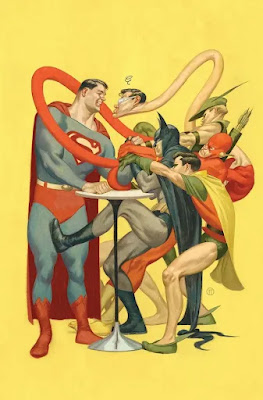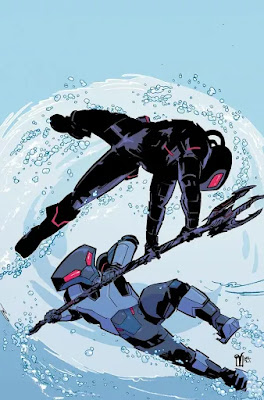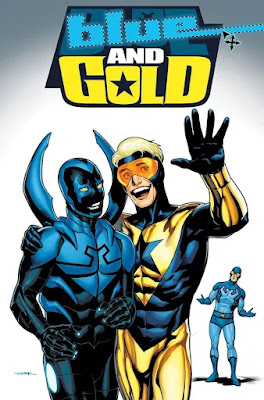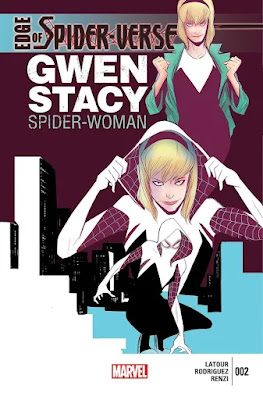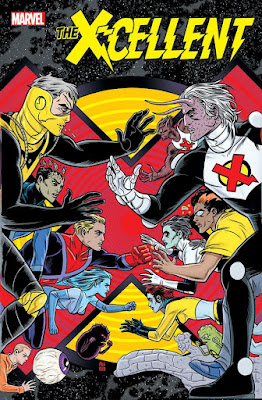 |
Von Eeden/Giordano
|
Every once in a while I'll remember the character Pagan, and wonder what some of the more vocal members of the modern, extremely-online comics readership would have made of this character had she debuted in, say, 2005 or 2019 instead of way back in 1992.
Pagan was on the many, many original creations of long-time Batman writer Alan Grant, although she is one those many creations that never caught on with other writers (along with the likes of Joe Potato, Wilde Chancer), unlike the handful of Grant creations who became mainstays in Batman comics (Mister Zsasz, Scarface and The Ventriloquist, Anarky).
A brutal vigilante who played too rough for Batman's taste, Pagan's "theme" was essentially a cartoonish version of feminism. Not only did she dress like a female gladiator and wear the symbol for woman over her left eye, but she would spout dialogue like "Very clever--for a man!" and, after he introduction, seemed to devote herself to the protection of the women of Gotham City from being preyed on by men.
You can see why she's an interesting comic book figure to consider in the twenty-first century, given how much superhero comics have become more welcoming to female readers, the backlash against it from certain, terrible but vocal corners of the fandom and, of course, the way the comics industry itself and certain terrible creators have targeted and victimized women in a variety of ways.
So, like I said, I often wonder how the character would be received today, and if Alan Grant and artist and co-creator Tom Mandrake might have presented her were they introducing her twenty years later, or if they even would have created such a character in the 21st century.
There are certainly aspects of the character that seem potentially problematic—including her origin, which is a sort of "fridging" with a twist—perhaps foremost among them being the fact that she was, of course, the creation of men who appeared in a comic targeted towards teenaged boys, and thus her brand of radical, ultraviolent feminism has more than a touch of the cartoonish about it.
Of course, this was at a time when Batman was presented as, if not exactly a pacifist, not nearly as violent as he would later be depicted, and was as adamant that vigilantes use minimum force as he was that other superheroes stay out of Gotham (Batman's main issue with The Huntress at the time, you may recall, was that she was too rough on criminals).
Pagan made her first appearance in Batman #479, late in Grant's run on the title. His long-time collaborator Norm Breyfogle had recently left the title, and, after a two-part fill-in by writer John Wagner, Grant would do just two more issues before the title was turned over to writer Doug Moench for a few more issues, before the build-up to the "Knightfall" saga began (Grant would leave Batman, but not Batman, launching his own, new title Batman: Shadow of The Bat with Breyfogle).
This issue, then, was the penultimate one of his Batman run, and was pencilled and inked by artist Tom Mandrake, with Adrienne Roy providing colors. Let's read it together, shall we...? (If you don't have a copy of your own, it's being collected in Batman: The Caped Crusader Vol. 6, scheduled for a February release; you can come back to this post then, if you like. It will still be here waiting for you. Promise.)
 |
| Mandrake |
COVER: There are a couple of interesting notes about the cover. It depicts the new character Pagan at its center, but Batman's still present in the form of his instantly identifiable shadow, falling across the new character, whose response to it shows that they appear to be in a somewhat adversarial relationship.
It's a pretty nice drawing. I've been a fan of Mandrake's since I first saw his work in the pages of 1990's Advanced Dungeons & Dragons #23, a fill-in issue on the series his wife was working on (and the first comic book series I read regularly), and I liked seeing him drawing superheroes. His depiction of Batman was pretty great, working within the design so perfected by Breyfogle, where the character was at once at thoroughly human-looking figure form the neck down, but with an incredibly expressive, almost alive-looking cape and cowl attached to him, through which he seemed to channel a more fantastical visual appearance (a taste of that is evident in the shadow on the cover, where you see the very human-looking broad shoulders, bunched with muscles, but every other element is an abstracted, grasping-looking shape of a giant nightmare bat).
As nice as the figure work on Pagan might be, you've probably already noticed it is a pretty classic example of the "brokeback" pose, in which the (usually male) artist draws a woman twisting her spine in a way that is maybe technically possible, but extremely uncomfortable unless your back is, you know, broken. This is usually done so that the artist can highlight both the character's ass and breasts in the same image.
It's ironic to see the image applied to this character, in one of only two covers she will ever appear on, because, as I said, her costumed crimefighting "theme" is feminism.
Also of interest may be the fact that she is wearing tights on the cover, but not inside the comic. Were here bare legs deemed to sexy for a mass market comic book aimed at younger readers in the year 1990? Wonder Woman dressed similarly though, and always had bare legs; did Mandrake simply draw the character's thong too small, necessitating editorial to have the colorist color her legs and ass so that it looked like she was wearing tights...?
PAGE 1: The first page of the issue is as silent splash-page, in which a nude man is seen bound and hanging from a fire escape, Batman posed dramatically just below him, and a newspaper headline in the background, with the headline "MISSING BANKER FOUND NEAR-DEAD!"
 |
| Mandrake |
PAGES 2-3: Batman and Lieutenant Kitch, a member of the GCPD who often appears in Grant's Batman comics, visit the missing banker, Bob Buick, in the hospital. He was missing for over a week and, the doctor says, had been "whipped-- beaten-- and there are definite signs of severe emotional distress!"
Mr. Buick is drawn covered in bandages, and is extremely cagey with Batman and Kitch, eventually throwing himself into his pillow and saying "Leave me alone! I don't remember anything! Please-- Just leave me!"
When the nurse comes in to ask them to leave, Buick reacts poorly: "Y-you stay away from me! I want a male nurse-- A male, do you hear?"
Batman and Kitch compare notes briefly in the parking lot, and then Batman throws a Batarang with rope attached off-panel, sailing up into the night like a kite. This is a pretty neat image by Mandrake, in which Batman's lower body seems to disappear within his cape, and he all but transforms into his own bat-symbol.
 |
| Mandrake |
PAGE 4: Batman wasn't leaving, though. He was just swinging up to the ledge outside Buick's room to spy on him. He witnesses Buick dial a number , and leave a frantic message for a Peter, telling him it's urgent and that Peter could be killed.
Batman, who saw and memorized the number he dialed, then sails off into the night in search of this Peter.
Mandrake repeats the image of Batman on his bat-line, but here from a greater distance, and we see the shadow he casts on the side of the hospital, which resembled the bat-symbol exactly.
 |
| Mandrake |
PAGES 5-7: Meanwhile, Peter is leaving The Glitz Club, his friends asking if he wants to go to Fat Martha's next, which is a weird name for a club. Peter declines, gets in his sports car and heads for home—until he's run off the road and directly into a lamp post. He's in the middle of yelling importantly at whoever totaled his car when the other driver opens the door and he slides out to behold the woman on the cover of the comic book.
"You can crash into me anytime!" he tells her. "You sure dress to please, sweetheart!"
"I dress to please myself," she says before kicking him in the face (BOOF!).
"I'll show you, girl--!" he responds in a fury, to which she replies, "The name is Pagan" and judo tosses him over his shoulder and directly onto the pavement (KRAAK).
PAGES 8-9: Batman follows some clues, starting with the wrecked sports car.
 |
| Mandrake |
PAGES 10-13: Peter is in an abandoned warehouse somewhere, with Pagan beating the shit out of him, taunting him as she does so, "Not very nice when someone makes
you plead, is it? Makes you sick when you realize
they have
all the power and you have
none, doesn't it?"
The scene jumps back and forth between Pagan and Peter and Batman. While she's beating on him, Batman finds her vehicle and realizes from the small footprints at the scene that it's a woman who took Peter.
He calls Kitch to see what ties Peter to Buick, and Kitch says bother appeared in court together a couple of years ago, "Case not proven. They walked."
The charge? "Assault and battery... on a girl."
Meanwhile, Pagan asks Peter if he remembers Sondra, and he begins to plead anew, "L-look-- we were drunk! It... it was an accident!"
"Beating a seventeen-year-old girl unconscious was an accident? You lying rat! Is that how you salved your conscience?"
 |
| Mandrake |
PAGES 14-16: Pagan and Batman both talk about Sondra now.
Pagan does so to Peter, crawling over the prone figure and noting the inherent unfairness of the judicial system when it comes to rich white guys accused of rape: "The judge was a man! He was guaranteed to believe two wealthy respectable yuppies! Of course the under-age drunk was lying! She was only seventeen. You left scars that could never heal. You stole her life!"
Meanwhile, Batman visits Sondra Mercer's parents, who talk about what those "animals" did to their daughter, and how she ruined them...and their whole family.
I should note here that the script never mentions the word "rape," only "assault," but it seems pretty clear that Sondra Mercer was raped. If the two men had really tortured her in some other way, well, the story doesn't really make sense unless she was sexually assaulted, but the Grant and/or DC seem reluctant to come right out and say the word "rape," even in the story that revolves around a rape.
Batman obviously expects Sondra might be the woman behind the abductions, and tells her parents that it's important he find her.
Her father responds, "Is this some kind of bad joke? Sondra committed suicide a week after the trial!"
This causes Batman to make a very weird sad/aghast/surprised face, furrowing the forehead of his cowl in a way that Jim Aparo excelled at drawing.
 |
| Mandrake |
PAGES 17-20: Batman's on the hunt again, there's a great seven-panel sequence in which we see him from afar, a bat-shape drifting over a scary urban environment, pausing long enough to note clues, and hurrying towards his appointed destination.
Pagan has pulled a knife on Peter, when Batman punches open the door, shouts "That's enough!" and batarang's the knife out of Pagan's hand.
The two argue, Batman telling her he knows she's really Marian, Sondra's sister. Here then is a case where a female character is raped and dies to motivate a character to action (i.e. "fridge"), but it's a female character motivated to action, rather than a male one.
"I'm
not Marian!" Pagan screams, then continues:
She's dead-- buried in the same grave as Sondra!
I'm Pagan! I've turned my back on your so-called civilization Pagan, do you hear!
Batman is still trying to talk her down when she throws Peter at him, then kicks him in the face in a pose that looks...not quite right to me, but hell, I can't recall seeing anyone being kicked directly in the face like that, so I can't really judge.
Batman just blocks and dodges her blows, eventually tripping her. She rants about how her breaking the law and beating the hell out of these two men will be worth it if even if just one man stops to think about what she did before hurting another woman, Batman saying she needs help and that she's broken the law and just has to pay. She then throws herself out the window.
There's a line outside the window though, which she grabs and slides down to her waiting motorcycle.
"A little forward planning Batman!" she tells him, and then, as she's about to ride off, "But you haven't heard the last of me! Gotham's a man's city-- it needs a woman to redress the balance!"
Batman doesn't need anyone to tell him the virtues of forward planning, of course. He had tied her motorcycle to a lamp post, so that when she sped off and the line grew taught, she flipped off her bike and hit the ground, knocked unconscious.
 |
| Mandrake |
Peter rushes to thank Batman, but he shoves him away to arms length: "--Don't ever thank me again!"
Was that the last we heard of Pagan?
No, no it was not.
She reappeared in 1993's
Batman: Shadow of the Bat Annual #1, the title's tie-in to the "Bloodlines" summer event that introduced the "New Blood" heroes and villains to the DC Universe (That's her real tiny under the clock face on Brian Stelfreeze's cover).
The annual's New Blood was Joe Public, a public school gym teacher who fashions himself a vaguely patriotic costume and who is inspired to take down the local drug dealer who he holds responsible for a student's overdose death. A total amateur who Batman advises to go home and watch TV after he gets in his way, Joe Public gets a super-power from the Parasite alien: After he's bitten, he has the ability to temporarily 'borrow" strength and stamina from those around him, retroactively making sense of his name (Fun fact: I hated Joe Public when I first read this, particularly his design, with his shaved mullet hairstyle, but re-reading it today, I kinda like the idea of a coach-turned-hero, and even the patriotic get-up; taken together, he's like a local, bargain version of Captain America).
Batman encounters Pagan as she's beating up a trio of thugs who threatened her in a typically comic book way ("What's the hurry, sister? All rush an' no fun makes Jill a dull girl!"). Afterwards, she catches him up on what she's been up to since Batman #479: She was acquitted, the jury saying she was justified in beating up the men who drove her sister to her death.
 |
| Von Eeden/Giordano |
"I vowed then to help the women of this city against the beasts that pray on them," she says to Batman. "That's why Marian Mercer became Pagan. It's a vow I'll keep till I go to my grave!"
As to why she's in an alley in the first place, she was acting as a decoy, hoping to find the mystery slasher who has been attacking people in Gotham lately, a slasher we already know is actually the Parasite on the cover. His name is Gemir, and he's the coolest-looking of the Parasites, all of which look like a cross between H.R. Giger's Aliens, which obviously inspired them, and dinosaurs; Gemir was red and looked a bit like a half-fossilized dragon. In his human form, he looked just as dumb as all his fellow Parasites.
Batman suggests they team up, to which Pagan agrees, reluctantly: "If this is some kind of patronizing trick, so you can keep an eye on me..." They eventually spot Gemir flying off to Blackgate Island with one of his latest victims; there he's storing the victims it doesn't kill and drain immediately in a sort of larder.
Batman tells Pagan to call the cops while he straps on a bat-shaped hang-glider and gives chase. She doesn't listen, but commandeers a boat to follow, ultimately saving his life with a bolo and a well-placed kick when Batman tries fighting Gemir hand-to-hand.
 |
| Von Eeden/Giordano |
Ultimately Joe Public saves the day, when his powers trigger, and he borrows enough strength from the crowd of victims to punch Gemir through the wall, survive a direct hit from him and chase him off.
"I'm just a phys ed teacher from the East Side--" Joe tells Batman as the Dark Knight theorizes about his sudden onset super-powers, "And after tonight's little drama , you can bet that's where I'm heading back! In the future, I'll leave crime to professionals!"
Despite that, Joe would return a few more times...including in the very next place Pagan appeared!
Her last appearance is more of a cameo really, and occurred in 1996's Batman: Shadow of The Bat #50. Alant Grant reteamed with five artists he had worked on the title with before (including Caleb-favorites Norm Breyfogle and Vince Giarrano) for this anniversary story that both introduced a new villain and included a premise that allowed for the appearances of all the villains and vigilantes that had previously appeared in the book and from throughout Grant's career on the character.
That new villain is named Narcosis, and he's vaguely Scarecrow-like, which might be the reason we never saw him again after this three-issue arc. He gases Batman in an in media res chase, after which Batman thinks he sees Clayface (the Ultimate Clayface that Basil Karlo became at the climax of "The Mud Pack"). Then he turns around and sees The Ventriloquist and Scarface! Than Amygdala, The Tally Man, The Corrosive Man and the demon Mahakala, until he finally realizes that he's dreaming—Narcosis' schtick, as we'll become aware, is to use chemicals to put people to sleep and subject them to terrible nightmares. At that point, Batman realizes that "if my mind can create villains-- --it can also create the means to defeat them!"
At that point we get a pretty great double-page splash in which a bunch of characters from Grant-written comics appear, Batman summoning an army of allies to help him against the army of villains. These include Robin Tim Drake and Commissioner Gordon, of course, and Anarky, but also plenty of minor characters, like The Human Flea, Joe Potato, Wilde, The Hood and, of course, Joe Public and Pagan.
 |
| Kitson, probably |
It's a pretty awesome image though, with almost every figure in it a particular one from a Grant-written or co-written comic, all fighting in a single, silent moment. I don't think there are many Batman writers who have created enough name heroes and villains to fill a crowd of this size, even 25 years later. I think it's penciled by Barry Kitson, but I'm not 100% sure; the artists involved aren't given credit for which pages they drew.
 |
| Kitson, I think |
And that seems to be the last we see of Pagan.
Outside of Batman's dreams, he's able to defeat Narcosis, who plans to poison Gotham's milk supply with his nightmare potions, and he does so with the help of Gordon, Alfred and Robin, not Pagan.
Hopefully she's still out there beating up would-be rapists in an alley somewhere...



























